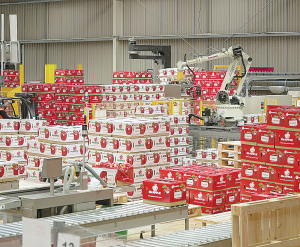US tariffs threaten NZ horticulture exports
"Unwelcome" is how the chief executive of the Horticulture Export Authority (HEA), Simon Hegarty, describes the 15% tariff that the US has imposed on primary exports to that country.
 The Horticulture Export Authority says non-tariff trade measures continue to remain a problem for exporters.
The Horticulture Export Authority says non-tariff trade measures continue to remain a problem for exporters.
Non-tariff trade measures (NTM) remain a problem for NZ exporters, according to Horticulture Export Authority (HEA) chief executive Simon Hegarty.
The HEA released its latest report on 'Barriers to NZ's Horticulture trade'. The 235-page report, produced by the HEA every two years, is effectively an encyclopaedia of what has happened and is likely to happen in the sector.
Hegarty says while existing trade barriers cost the sector around $135 million a year, it's the NTMs that are causing NZ real grief on a daily basis.
Hegarty says these include overly complex regulations and the lengthy time taken by some countries to process an application for a new product to enter their market. Other barriers include compliance around phytosanitary requirements, product labelling, pre-shipment inspections and just getting goods cleared through customs, to name a few.
He says there are other headwinds facing the sector 10-15 days longer to get to Europe and that is disrupting the whole global shipping schedules," he says.
Hegarty says NZ is an isolated nation which struggles to attract freight providers because some of the routes to and from Asia to Europe and the USA are more lucrative.
On the other hand, he says NZ is benefiting from the recent NZ/EU FTA which came into force this year; the removal of tariffs resulted in a $27 million dollar benefit. Other FTAs in the Middle East also had a positive impact, he says.
The HEA report shows that horticulture exports for 2024 were worth $4.9 billion - up just 2% on 2022. But the report notes that this growth in dollar terms came at a time when the actual volume of exports declined by 11%.
Hegarty says kiwifruit and apples make up 77% of horticulture's export revenue with onions coming in third place. He says China is the biggest buyer of our products, followed by the EU, Japan and Australia.
Meanwhile, like other sectors, horticulture is also finding it a challenge to secure a trade deal with India.
NZ hort exports to India amount to just over $78 million - mainly apples but also some kiwifruit. The trouble is apple exports attract a 50% tariff and kiwifruit 30% which cuts into profit margins.
In the past week, a delegation of horticulture exporters (no politicians) representing kiwifruit, apples and pears, onions, avocados, the HEA and others have been in India. Their objective is a reconnaissance mission to get a better handle on the opportunities there, the logistics of increasing our market share and getting a first-hand understanding of how India does business.
The National Wild Goat Hunting Competition has removed 33,418 wild goats over the past three years.
New Zealand needs a new healthcare model to address rising rates of obesity in rural communities, with the current system leaving many patients unable to access effective treatment or long-term support, warn GPs.
Southland farmers are being urged to put safety first, following a spike in tip offs about risky handling of wind-damaged trees
Third-generation Ashburton dairy farmers TJ and Mark Stewart are no strangers to adapting and evolving.
When American retail giant Cosco came to audit Open Country Dairy’s new butter plant at the Waharoa site and give the green light to supply their American stores, they allowed themselves a week for the exercise.
Fonterra chair Peter McBride says the divestment of Mainland Group is their last significant asset sale and signals the end of structural changes.

OPINION: Your old mate welcomes the proposed changes to local government but notes it drew responses that ranged from the reasonable…
OPINION: A press release from the oxygen thieves running the hot air symposium on climate change, known as COP30, grabbed your…